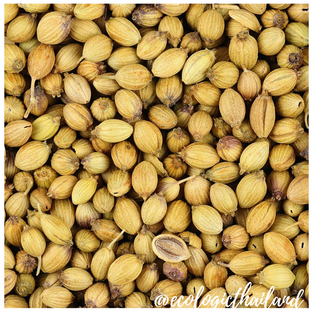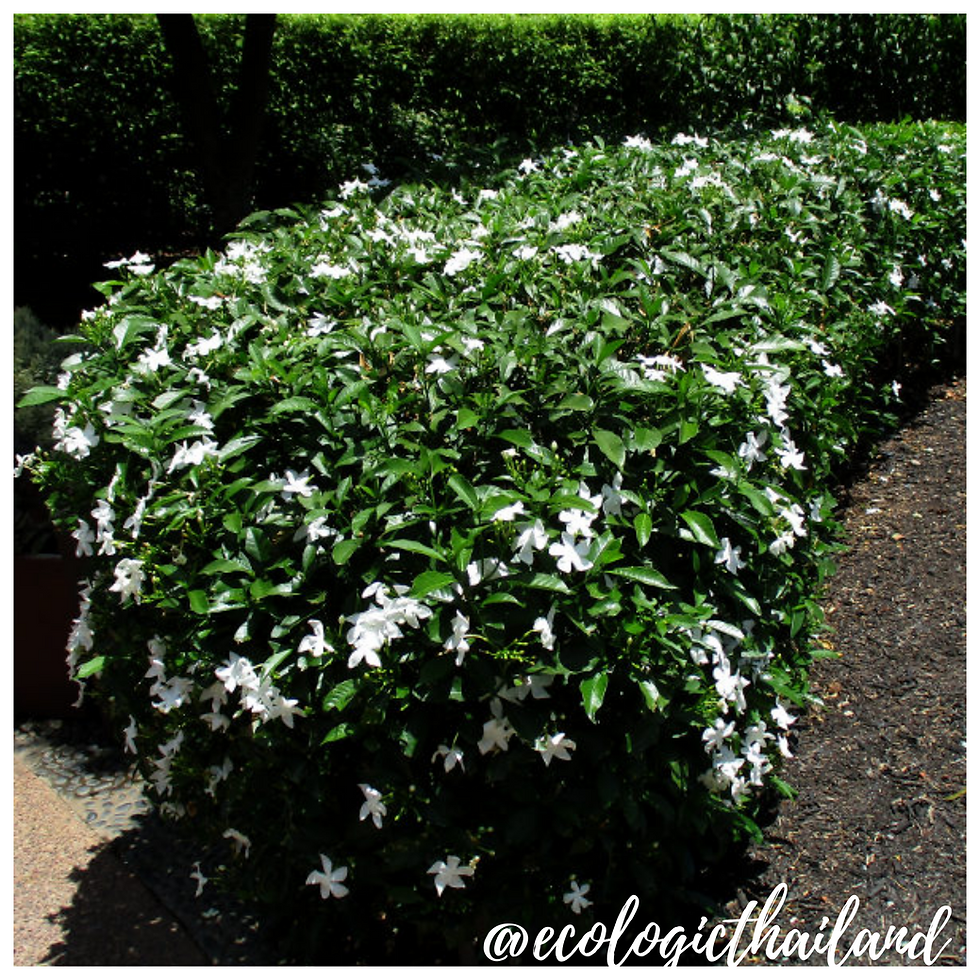Coriander - Cilantro
- Eco-Logic Resort
- Jan 22, 2021
- 4 min read
Pakchee | ผักชี | Coriandrum Sativum
Family: Apiaceae - Genus: Coriandrum

Cilantro, or coriander, can be found around the area of the gardens of the Thai Child Development Foundation and in the kitchen area of the Food Forest Kitchen restaurant.
Coriander (cilantro) is an annual herb that grows 15-60 centimeter high. The herb has a bright green color and has erect stems that branch out and support leaves. The lowest leaves are stalked and pinnate, the leaflets roundish or oval, and slightly lobed. The segments of the uppermost leaves are linear and more divided. The flowers are in shortly-stalked umbels, five to ten rays, pale mauve and almost white. The seed clusters are very symmetrical and the seeds fall as soon as they ripen.
Coriander and cilantro (the Spanish word for coriander) are the same herb. In some parts of the world coriander refers to the seed and the word cilantro refers to the leaves; in most parts of the world, the word coriander covers the whole plant.
Coriander is an annual herb. All parts of the plant are edible, but the fresh leaves and the dried seeds (as a spice) are most traditionally used in cooking. Most people perceive the taste of coriander leaves as a tart, lemon/lime taste, but to some the leaves taste like dish soap (this is actually linked to a gene which detects some specific aldehydes that are also used as odorant substances in many soaps and detergents).
From the time of sowing seed, Coriander leaves can begin to be harvested in about three to four weeks. Coriander seeds can be harvested in about 45 days.

THE PLANT
Coriander is a annual herb, growing to 60 cm tall.
The plant has a bright green color and has erect stems that branch out and support leaves. The lowest leaves are stalked and pinnate, the leaflets roundish or oval, and slightly lobed. The flowers are in shortly-stalked 'parasol shapes', The color of the flowers are pale mauve and almost white. The seed clusters are very symmetrical and the seeds fall as soon as they ripen.

THE LEAVES
The leaves are variable in shape, broadly lobed at the base of the plant, and slender and feathery higher on the flowering stems.

THE FLOWERS
The flowers are edible, the torn petals can be used as a garnish, or whole flowers in drinks.
The flowers are in shortly-stalked 'parasol shapes', The color of the flowers are pale mauve and almost white.

THE FRUIT AND SEEDS
The fruit is 3–5 mm in diameter. Technically, Cilantro fruits are "schizocarps," which are dry fruits that split into two halves, each half referred to as a "mericarp." Each mericarp contains one seed. ...

The dry fruits are coriander seeds. The seeds have a lemony citrus flavor when crushed. It is described as warm, nutty, spicy, and orange-flavored.

THE ROOTS
Coriander roots have a deeper, more intense flavor than the leaves, and are used in a variety of Asian cuisines, especially in Thai dishes such as soups or curry pastes.
CULINARY USES
Roots are used for flavoring foods like curry and pickling juices.
The fresh leaves are an ingredient in many foods, such as chutneys and salads, salsa, guacamole, and as a widely used garnish for soup, fish and meat. As heat diminishes their flavor, coriander leaves are often used raw or added to the dish immediately before serving.
The dry fruits are coriander seeds. The seeds have a lemony citrus flavor when crushed, it is a warm, nutty, spicy, orange-flavored.
The seeds can be crushed or used whole and added as an ingredient to a variety of foods.
NUTRITION
Raw coriander leaves are 92% water, 4% carbohydrates, 2% protein, and less than 1% fat.
The nutritional profile of coriander seeds is different from the fresh stems or leaves.
In 100 gram coriander leaves are particularly rich in vitamin A, vitamin C and vitamin K.
Although seeds generally have lower content of vitamins, they do provide significant amounts of dietary fiber, calcium, selenium, iron, magnesium and manganese.
TRADITIONAL MEDICINAL USE OF NEEDLE FLOWER
NOTE: please take advice from a doctor if you are planning to use herbal medicine.
Seeds are said to be used to:
When made into seed oil and added to massage oil, it can be used to treat facial neuralgia and cramps.
When made into a tea of coriander seeds and rose petals is used as a remedy for menstrual discomfort; often used to mask the taste of bitter herbal teas; sedative, soothing, diuretic; treats inflamed gums, earache, menstrual cramps.
For nervousness, crushed seeds of cilantro, can be added to put in port wine to drink.
Coriander seeds are found in internal formulas designed to treat digestive issues, such as gas.
Leaves are said to be used for:
Treating a wet cough/mucous cough, drink tea made of the leaves . The tea should be at room temperature water.
Roots are said to be used for:
Coriander root decoction treats acute injuries to the eye (external application).
INTO THE WILD: a down to earth experience

For guests and visitors to Paksong we organize weekly tours "The Edible Forest" and Foraging weekends: Into the Wild. We work with local guides to take you in the jungle of Paksong. After foraging, we will cook a meal with the ingredients, using bamboo together with you!
Come and join and learn about the abundance of food that nature gives us!
INTO THE WILD!


















Comments